|
 There
is little variation within the pattern of scales among the different
varieties of garter snakes, but coloration varies widely across
varieties and geographic regions. There
is little variation within the pattern of scales among the different
varieties of garter snakes, but coloration varies widely across
varieties and geographic regions.
I see a pattern here: The pattern on these snakes consists of one or three longitudinal
stripes on the back, typically red, yellow or white. The snake genus
got its common name because people described the stripes as resembling
a garter. In between the stripes on the pattern are rows with blotchy
spots. Even within a single species the color in the stripes and
spots and background can differ. In some species the stripes vary
little in color from the adjacent bands or background and are not
readily seen. Most garter snakes are under 60 cm (24 inches) long,
but can be larger. T. gigas is capable of attaining lengths of 160cm.
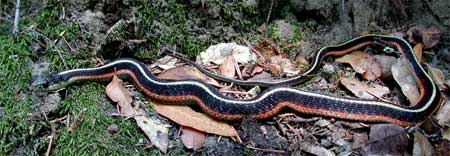

Anywhere in the world: It is one of the northernmost species of snake in the world, possibly
second only to the Crossed Viper, Vipera berus. The genus is so
far ranging due to its unparticular diet and adaptability to different
biomes and landforms, from marshes to hillsides to drainage ditches
and even vacant lots, in both dry and wet regions, with varying
proximity to water and rivers. Though, as you approach the western
portion of the continent these snakes are more water-loving than
on the eastern portion. Northern populations hibernate in larger
groups than southern ones. Despite the decline in their population
from collection as pets (especially in the more northerly regions
in which large groups are collected at hibernation), pollution of
aquatic areas, and introduction of bullfrogs and bass as predators,
this is still a very commonly found snake. The San Francisco garter
snake, Thamnophis sirtalis tetrataenia, however, is an endangered
subspecies and has been on the endangered list since 1967. Predation
by crayfish has also been responsible for the decline of the narrowhead
garter snake.
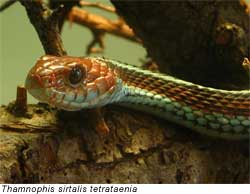 Too numerous to count: There is no real consensus exactly how many species of Thamnophis there are, and disagreement among taxonomists and sources, such
as field guides, over whether two types of snakes are separate species
or subspecies of the same species is common. They are also closely
related to the snakes of the genus Nerodia, and some species have
been moved back and forth between genera. Too numerous to count: There is no real consensus exactly how many species of Thamnophis there are, and disagreement among taxonomists and sources, such
as field guides, over whether two types of snakes are separate species
or subspecies of the same species is common. They are also closely
related to the snakes of the genus Nerodia, and some species have
been moved back and forth between genera.
What's for dinner?: Garter snakes, like all snakes, are carnivorous. Their diet consists
of almost any creature that they are capable of overpowering: insects,
slugs, snails, earthworms, leeches, rodents, lizards, amphibians
and sometimes they will even consume carrion and even baby birds.
When near the water, they will eat fish. The ribbon snake in particular
loves frogs (including tadpoles), readily eating them despite their
strong chemical defenses. Food is swallowed whole. Although dining
mostly upon live animals, they will sometimes eat eggs as well.
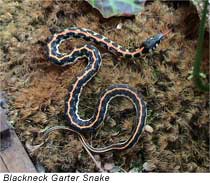 Quite the charmer: Garter snakes of all species are gregarious (when not in hibernation
or aestivation). They have complex systems of pheromonal communication.
They can locate other snakes by following their pheromone-scented
trails. Male and female skin pheromones are so different as to be
immediately distinguishable. However, sometimes a male garter snake
is born that has both male and female pheromones. During mating
season, male snakes are often fooled into thinking these snakes
are female by their pheromones, and will try to mate with them.
These males with the female pheromone genetic variation are among
the first to mate, attracting females while other males are still
fooled into being attracted to them. Quite the charmer: Garter snakes of all species are gregarious (when not in hibernation
or aestivation). They have complex systems of pheromonal communication.
They can locate other snakes by following their pheromone-scented
trails. Male and female skin pheromones are so different as to be
immediately distinguishable. However, sometimes a male garter snake
is born that has both male and female pheromones. During mating
season, male snakes are often fooled into thinking these snakes
are female by their pheromones, and will try to mate with them.
These males with the female pheromone genetic variation are among
the first to mate, attracting females while other males are still
fooled into being attracted to them.
Run and Hide: If disturbed, a garter snake may strike, and will often coil, but
typically it will hide its head and flail its tail about. These
snakes will also discharge a malodorous, musky-scented secretion
from their anal gland. They often use these techniques to escape
when ensnared by a predator. They will also slither into the water
to escape a predator on land. Hawks, crows, raccoons, crayfish and
other snake species (such as the coral snake and king snakes) will
eat garter snakes, with even shrews and frogs eating the juveniles.
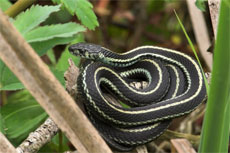 Laying Out: Being heterothermic like all reptiles, garter snakes bask in the
sun to keep their body temperature warm (at 28 to 32 degrees Celsius)
during the morning. The temperature is lower during the evening.
Garter snakes will often sleep together to keep their body temperature
warm at night. They also sleep in large nests next to one another's
body during hibernation. These snakes will migrate large distances
to hibernate. Laying Out: Being heterothermic like all reptiles, garter snakes bask in the
sun to keep their body temperature warm (at 28 to 32 degrees Celsius)
during the morning. The temperature is lower during the evening.
Garter snakes will often sleep together to keep their body temperature
warm at night. They also sleep in large nests next to one another's
body during hibernation. These snakes will migrate large distances
to hibernate.

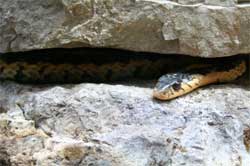 Empty Nest: Garter snakes begin mating as soon as they emerge from hibernation.
During mating season, the males will mate with several females.
Males comes out of their dens and, as soon as the females begin
coming out, will surround them. A male sends out pheromones, and
the female will follow the pheromones to an attractive male and
mate with him. Once impregnated, a female will retire from the mating
ring and find food and a place to give birth. Female garter snakes
are able to store the male's sperm before beginning the accouchement.
The young are incubated in the lower abdomen, at about the midpoint
of the length of the mother's body. Garter snakes are ovoviviparous.
Gestation is two to three months. As few as 3 or as many as 50 may
be born in a single litter. The babies are independent upon birth,
abandoning the mother. Empty Nest: Garter snakes begin mating as soon as they emerge from hibernation.
During mating season, the males will mate with several females.
Males comes out of their dens and, as soon as the females begin
coming out, will surround them. A male sends out pheromones, and
the female will follow the pheromones to an attractive male and
mate with him. Once impregnated, a female will retire from the mating
ring and find food and a place to give birth. Female garter snakes
are able to store the male's sperm before beginning the accouchement.
The young are incubated in the lower abdomen, at about the midpoint
of the length of the mother's body. Garter snakes are ovoviviparous.
Gestation is two to three months. As few as 3 or as many as 50 may
be born in a single litter. The babies are independent upon birth,
abandoning the mother.
All text is available under the terms
of the GNU Free Documentation License
|